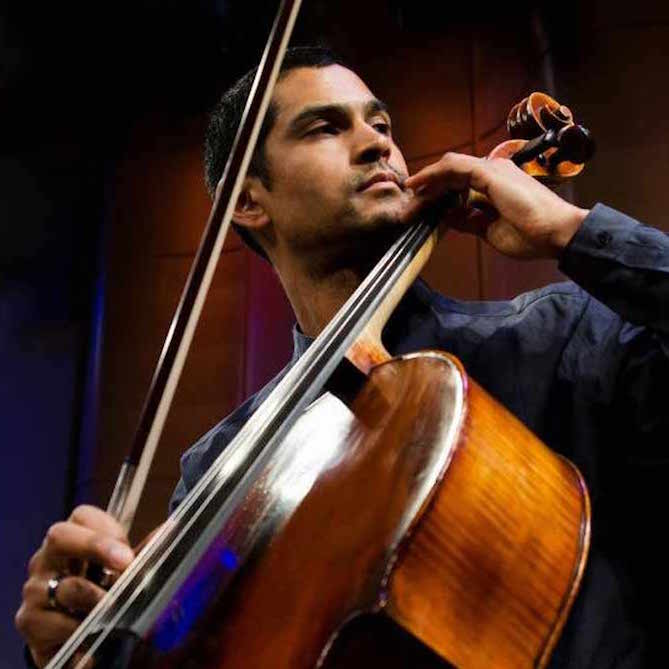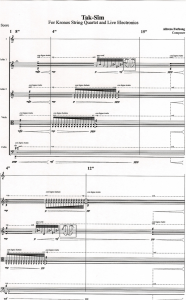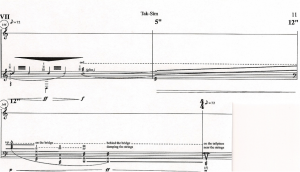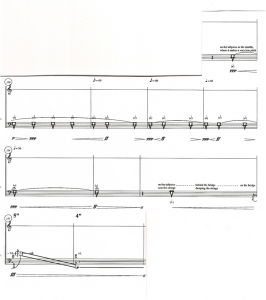
Tak-Sîm (Pt. 2)
Jeffrey Zeigler
Here in Part Two of my discussion on Tak-Sîm by Alireza Farhang, I am going to focus on his application on various extended cello techniques. On this topic, I found his approach to be quite fascinating and one that I am especially excited to share with everyone here in the cello community.
The piece begins with an audio trigger that I execute by pressing on a foot pedal. The trigger is a low, ambient sound that is sonically enhanced when I play a tremolo on the stick of the bow thus creating an almost a breathless quality.
Although a relatively simple technique, for this technique I would suggest using what I call a “guilt free” bow. The reason is because there is a large crescendo at the tail end of the note. This requires a great deal of bow pressure, beyond what I would feel comfortable doing on a decent bow. So what is a “guilt free” bow you ask? For me this is a bow that is not worth very much money and one that you don’t mind wacking around a bit. I have two. One is wooden that I playfully call “the club” and the other is a carbon fiber bow made in China. Both actually sound pretty good and can bounce pretty well.
At this point I would like to comment on the fact that Alireza did something that is unfortunately all too rare in the world of composition. It is true that in his quartet he asks all of us to do many things that we do not normally do. That said, he also did his homework. Alireza actually went out and got a hold of a cello and experimented to find various sounds on the instrument. So when I would say to him, “this is not playable” he would actually respond “you do it like this.” For this I have to give him a great deal of credit. Surprisingly enough, this is only the second time that i have ever had this type of experience working with a composer. And both times i have found that I have discovered new ways of creating sound. My guess is that this is probably due to the fact that a composer does not go in with a set idea of how sound is created on a cello. I would encourage all composers to try this sometime.
It is mainly near the end of the piece that Alireza unleashes his arsenal of extended cello techniques. In fact, the entire last 5 minutes or so is one big cello solo. The solo begins with a high double stop tremolo that rises up until you finally reach the bridge with your left hand. But you do not stop there! You continue tremoloing on the bridge creating a pitchless fuzz until you allow the bow to finally emerge on the far side of the bridge creating a dissonant chord. Again, you do not stop there! The tremolo continues down the cello to the point where the strings touch the tail piece. OK, now you hit a stop sign: fine tuners. So after taking a breath, you finish the phrase with a tremolo on the tail piece.
Next secton: bow the end pin. Whenever I bow the end pin I usually get a high harmonic. But as a result of his experimentation he knew a way to achieve a different sound. He asked for me to play a very low pitch which required a great deal of pressure. This is not an easy sound to make…and not very easy to control either!
And after a quick scordatura from C to B, Alireza next asks the cellist to play a tremolo between two harmonics located above the fingerboard in “rosin land.” As many of you already know, harmonics in this territory are pretty fussy. When I asked Alireza about them, he simply said, “I want the audience to feel your struggle.” Thanks, Dude.
But all of this leads to the solo’s most expressive moment. It is a melody played with left hand pizzicato meant to mimmic the sound of a setar. This melody is accompanied by sul ponticello tremolo and alternating between varied pitched and unpitched harmonics. This is a really beautiful sonic effect and a great moment in the music.
So how does a composer come to this point to ask a musician to do so much extreme extended technique. I cannot answer for all composers. But in Alirezah’s case the inspiration is actually completely musical. In his program notes, he writes: “The idea came to me in Autumn 2009 during a seminar at Columbia University,” recalls Alireza Farhang. “A young Turkish composer living in New York played a recording of some traditional Turkish music performed on a solo instrument. After the piece finished, he asked the audience to identify the instrument. The general opinion was that it could only have been a traditional Turkish instrument. This seemed right because everything about the sound, style, and intonation all sounded Turkish…nobody could guess that it was actually a cello! I then realized how the style, the intonation, the intervals, the articulations, all of the various qualities of holding a note, can change the character of an instrument and it’s identity. Thus was born Tak-Sîm.”
Subjects: Repertoire





